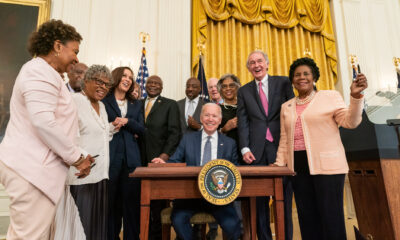March on Washington,politics
Black America Then And Now

The March on Washington in 1963 occurred during a time of great economic and education distance between African Americans and Whites. But, in the years since the 1960 Census, statistics show African Americans have closed the income gap dramatically and achieved academically in an impressive manner.
African Americans still trail Whites economically and scholastically, but the gaps are closing. According to the Census statistics analyzed by TheVillage, Whites earned almost twice as much as African Americans in the 1960’s. That differential is now less than 30 percent. On the education front, more than twice as many Whites as African Americans graduated from college in 1960. Today, only 20 percent more Whites than African Americans have college degrees.
Here is a breakdown comparing the 1960 black experience to current times, compiled from www.census.gov:
- Education: According to the Current Population Survey, in 1962, among people 25 years and older, 9.5 percent of the White population had completed four or more years of college, compared to 4.0 percent of the Black population. In 2012, 31.3 percent of Whites and 21.2 percent of Blacks had completed four or more years of college.
- Income: In 1963, the median income was $1,668 for Blacks and $3,105 for Whites (equivalent to $10,719 and $19,953, respectively, in 2011 dollars). In 2011, median income was $21,276 for Blacks and $27,451 for Whites.
- Population: The 1960 Census counted 179 million people in the United States. Whites accounted for 88.6 percent of the population, while Blacks accounted for 10.5 percent. In 2012, these groups counted for 78.4 and 13.7 percent, respectively, of the more than 316 million U.S. residents.
The 1960 census brought sweeping changes to the American counting system, affecting African Americans in a transforming approach.
The United State Census Bureau says 1960 marked the birth of the first mail-out census. Earlier censuses had used self-enumeration on a limited scale, but 1960 was the debut for this technique as a primary method for the collection of population and residential data.
The agency adds the postal service delivered questionnaires to every occupied housing unit. Householders were asked to complete the questionnaire and hold it for an enumerator to pick up.
The Constitution requires the population to be counted every ten years, a practice dating back to 1790.
There are reports showing flaws in the 1960 census. The Bureau says studies revealed that the census had undercounted certain segments of the population. Researchers also noted a growing distrust of government and resistance to responding to the census, despite an increasing need for accurate information in both the private and public sectors.
Agency leaders add in large measure, the increased need for data resulted from the federal government’s reliance on population and other information collected by the census when distributing funds to state and local governments.
Since that time, most recently the 2010 census, the U.S. Census Bureau has made significant efforts to improve the integrity of the census.
Factual information complied from www.census.gov.

-

 Featured10 months ago
Featured10 months agoCalifornia Is the First State to Create A Public Alert for Missing Black Youth
-

 Featured10 months ago
Featured10 months agoAfrican American Leaders Stay the Course Amid Calls for President Biden To Bow Out of Race
-

 Featured10 months ago
Featured10 months agoThe Debate Fallout Lands on Both Candidates
-

 Featured9 months ago
Featured9 months agoPresident Joe Biden Decides to Withdraw from the Presidential Race
-

 Featured9 months ago
Featured9 months agoIn One of His Final Speeches as President, Biden Says It’s Time for ‘Fresh Voices’
-

 Featured10 months ago
Featured10 months agoPresident Joe Biden Describes Shooting of Donald Trump As ‘Sick’







